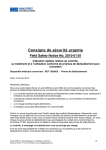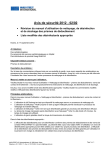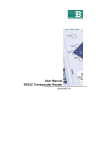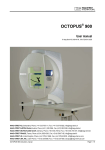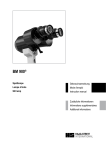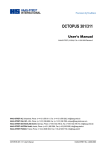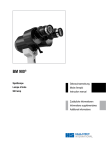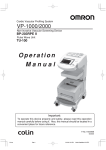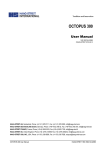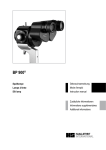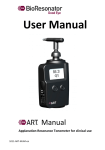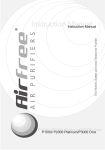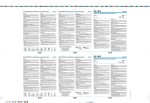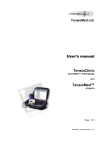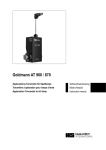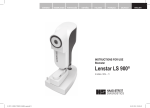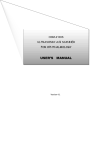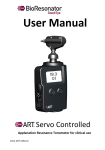Download English manual - augenarztbedarf.de & ophthalworld.de
Transcript
SVENSKA NEDERLANDSE ESPAÑOL ITALIANO FRANÇAIS DEUTSCH ENGLISH INSTRUCTIONS FOR USE Applanation Tonometer AT 900® D 12th Edition / 2010 – 07 © HAAG-STREIT AG, 3098 Koeniz, Switzerland - HS-Doc. no. 1500.7220067.04120 – 12. Edition / 2010 – 07 IFU_AT900D-7220067-04120_eng.indd 1 DOK. no. 1500 1500.1400209.04000 1 29.07.10 13:20:12 ENGLISH DEUTSCH FRANÇAIS INSTRUCTIONS FOR USE Applanation Tonometer AT 900® D 12th Edition / 2010 – 07 ITALIANO ESPAÑOL NEDERLANDSE SVENSKA Preface Thank you for choosing HAAG-STREIT equipment. By observing these instructions carefully you can assure the reliable and straightforward use of our product. Purpose of use The Applanation Tonometer AT 900 D is an accessory for use with the slit lamp series 900 and serves for the measurement of intraocular pressure. Due to its adaption possibilities it is optimised for use with HAAG-STREIT slit lamps. Thanks to its versatility the Applanation Tonometer can also be assembled on other slit lamps. Applanation Tonometer serves to examine and diagnose patient’s eye conditions. They are mainly used in doctor’s practices, infirmaries and universities under normal environmental conditions. Applanation tonometry may only be carried out by qualified and suitably trained medical staff. Caution: Federal law restricts this device to sale by or on the order of a physician or practitioner. 2 IFU_AT900D-7220067-04120_eng.indd 2 © HAAG-STREIT AG, 3098 Koeniz, Switzerland - HS-Doc. no. 1500.7220067.04120 – 12. Edition / 2010 – 07 29.07.10 13:20:12 SVENSKA ESPAÑOL NEDERLANDSE ITALIANO FRANÇAIS DEUTSCH ENGLISH Table of Contents 1 Safety.........................................................................4 1.1 Ambient conditions.................................................................................. 4 1.2 Transport and unpacking........................................................................ 4 1.3 Installation warning notices..................................................................... 4 1.4 Operation, environment.......................................................................... 4 1.5 Cleaning / disinfecting the measuring prism........................................... 5 1.6 Visual inspection of the measuring prism for damage............................ 6 1.7 Period of use........................................................................................... 6 1.8Inspection................................................................................................ 7 1.9 Cleaning the housing.............................................................................. 7 1.10 Guarantee and third-party product liability.............................................. 7 1.11 Pictographs and type plate..................................................................... 7 4. Technical data.........................................................20 5 Statutory regulations.............................................21 6. Classification..........................................................21 7.Environment............................................................21 8. How to disinfect......................................................22 2.Installation.................................................................8 2.1 2.2 2.3 2.4 AT 900 D model R................................................................................... 8 AT 900 D model T................................................................................... 8 AT 900 D model BQ................................................................................ 8 Magnet unit for automated L/R eye recognition...................................... 8 3.Operation...................................................................9 3.1Overview................................................................................................. 9 3.2 General set-up........................................................................................ 9 3.3 Which slit lamp is suited to which tonometer........................................ 10 3.4 Description of models........................................................................... 10 3.5Operation.............................................................................................. 11 3.6 Preparing the patient............................................................................. 11 3.7 Preparing the equipment....................................................................... 11 3.8 Activation, battery test and configuration of the tonometer................... 12 3.9 Patient instructions................................................................................ 14 3.10 Correct measurement........................................................................... 14 3.11 Source of errors.................................................................................... 15 3.12 Tips for the measurement..................................................................... 17 3.13Astigmatism.......................................................................................... 17 3.14 How the pressure is measured............................................................. 17 3.15Maintenance......................................................................................... 18 3.16 Replacement of batteries...................................................................... 19 3.17 Error messages..................................................................................... 20 © HAAG-STREIT AG, 3098 Koeniz, Switzerland - HS-Doc. no. 1500.7220067.04120 – 12. Edition / 2010 – 07 IFU_AT900D-7220067-04120_eng.indd 3 3 29.07.10 13:20:12 ENGLISH DEUTSCH FRANÇAIS ITALIANO ESPAÑOL 1.Safety NEDERLANDSE 1.2 Shipping and unpacking • Symbols Symbols correspond to EN 980 and ISO 15223-1. Other symbols that are used in these instructions: FORBIDDEN! Not observing these notes will lead to material damage and the endangering of patients. WARNING! These must be absolutely adhered to ensure safe operation of the instrument and to avoid endangering users and patients. NOTE! Important notes! Please read carefully. 1.1 Ambient conditions Transport: Temperature -40°C to +70°C Atmospheric pressure 500 hPa to 1060 hPa Relative humidity 10% to 95% Storage: Temperature -10°C to +55°C Atmospheric pressure 700 hPa to 1060 hPa Relative humidity 10% to 95% Operating: Temperature +10°C to +35°C Atmospheric pressure 800 hPa to 1060 hPa Relative humidity 30% to 75% 4 IFU_AT900D-7220067-04120_eng.indd 4 SVENSKA • • • Before you unpack the instrument, check whether the packing shows traces of improper handling or damage. If this is the case, inform the haulier which has delivered the product to you. Unpack the instrument together with a representative of the haulier. Prepare a protocol describing the parts that are possibly damaged. This must be signed by you and by the representative of the haulier. Leave instrument in the packing for several hours before unpacking (condensation). The Applanation Tonometer must be checked for damage after unpacking. Return faulty instrument in proper packing. The permanent magnets for automatic detection L/R (available as an option) may be used only with the AT 900 D. Other measuring instruments, in particular mechanical tonometers, can be influenced by the magnetic field. 1.3 Installation warning notices The installation is carried out according to section 2 - maintenance and control, and according to segment 3.15 - maintenance. NOTE! For assembly on other manufacturer’s equipment, the connection mass of the different tonometer models must be taken into account! Check: Do the connecting parts fit correctly (tonometer on the slit lamp, measuring prism)? 1.4 Operation, environment NOTE! The instrument may only be operated by qualified and trained staff. Training is the responsibility of the user. Only HAAG-STREIT accessories may be used. Moisture must be avoided. © HAAG-STREIT AG, 3098 Koeniz, Switzerland - HS-Doc. no. 1500.7220067.04120 – 12. Edition / 2010 – 07 29.07.10 13:20:13 SVENSKA NEDERLANDSE WARNING! As far as possible do not carry out an examination when eye infections or cornea injuries are present! There is no absolute contraindication for the execution of the tonometry. Professional assessment and caution are appropriate. 1.5 Cleaning / disinfection of the measuring prism WARNING! Use only clean, undamaged and disinfected measuring prisms! The instructions in chapter 5 regarding disinfecting must be followed unconditionally! • • • • • • • • • Measuring prisms are dispatched in a non-disinfected condition. Examinations may only be carried out with measuring prisms that are cleaned and disinfected correctly. Diseases can be transferred to patients and measuring prisms can be damaged by incorrect disinfection. Disinfectant residues in the patient’s eyes can lead to irritation or chemical burns. Therefore prisms must be thoroughly rinsed after disinfection. The measuring prisms must be removed from their mountings and placed in the disinfectant solution. The measuring prisms may not be disinfected together with other instruments and devices (danger of mechanical damage!) For an optimal cleaning and disinfection the measuring prisms must be submerged and must move freely in the fluid. Prior to disinfection the measuring prisms must be rinsed under cold running water for 30 to 60 seconds. Extremely dirty measuring prisms can additionally be cleaned using a mild soap and a cotton-wool ball. After disinfection the measuring prisms must be rinsed thoroughly under running cold drinking water for 10 to a maximum of 60 minutes. The measuring prisms should then be dried with a clean, soft single-use cloth, and stored in a clean dry, closable container. Only clean and undamaged measuring prisms may be used. Residues can lead to irritation of the patient's eye or chemical burns. © HAAG-STREIT AG, 3098 Koeniz, Switzerland - HS-Doc. no. 1500.7220067.04120 – 12. Edition / 2010 – 07 IFU_AT900D-7220067-04120_eng.indd 5 ESPAÑOL ITALIANO FRANÇAIS DEUTSCH ENGLISH NOTE! Disinfection may only be carried out using disinfectants that have been checked for material compatibility by HAAG-STREIT. The current compatibility list is enclosed with every tonometer and every measuring prism. It can also be found on the HAAG-STREIT AG homepage (www.haag-streit. com). The exact effectiveness, concentration and stand times can be taken from the manufacturer’s recommendations and references. FORBIDDEN! The measuring prism is made from PMMA material. The following restrictions are valid: - disinfection with alcohol - cleaning with acetone - disinfection with UV irradiation - sterilisation with steam or ethylene oxide - immersion in fluid for longer than one hour - temperatures over 60 °C NOTE! We recommend our DESINSET for efficient disinfection and storage. 5 29.07.10 13:20:13 ENGLISH DEUTSCH FRANÇAIS ITALIANO ESPAÑOL NEDERLANDSE SVENSKA 1.6 Visual inspection of the measuring prism for damage WARNING! Do not use damaged measuring prisms. Prior to each use, the contact surface of the measuring prism must be checked for contamination or damage (scratches, cracks or sharp edges.) This must be carried out using the slit lamp microscope at a 10 to 16 x magnification. When found to be damaged, the measuring prism may no longer be used to avoid damage to the patient’s cornea. Disinfectant can penetrate into cracks in the measuring prism and lead to chemical burns on the patient’s eye during tonometry. 1.7 Period of use 2015 - 10 year 0 year 1 first use year 2 year 3 Period of use maximum 2 years year 4 year 5 replacement Period of use maximum 2 years fabrication first use replacement WARNING! How long may measuring prisms be used? Due to the large number of variables to be taken into account (type and concentration of the disinfectants used, number of patients, handling etc.) it is practically impossible to make a statement as to how often and/or how long a measuring prism can be safely used. The measuring prisms are engraved with an expiry date ( YYYY-MM). They must not be used beyond this date. HAAG-STREIT recommends a maximum service life of two years before the expiry date. This service life applies subject to normal conditions of use, i.e., in compliance with the instructions contained in these instructions for use. The period of use begins with the first application. The given time periods are not valid for damaged measuring prisms, they must be immediately replaced. 6 IFU_AT900D-7220067-04120_eng.indd 6 © HAAG-STREIT AG, 3098 Koeniz, Switzerland - HS-Doc. no. 1500.7220067.04120 – 12. Edition / 2010 – 07 29.07.10 13:20:13 SVENSKA NEDERLANDSE 1.8Inspection The tonometer must be maintained every month according to point 3.15. Physically damaged by outside influences (e.g. by impacting, dropping) requires an inspection in any case. NOTE! Should a refurbishing be necessary then contact your HAAG-STREIT representative. ESPAÑOL ITALIANO FRANÇAIS DEUTSCH ENGLISH 1.11Pictographs and type plate a) Read very carefully (in the instruction manual) b) Manufacturer c) HS-Part Number d) Date of manufacture e) Serial number b c d e 1.9 Cleaning the housing Use only a cloth that has been moistened slightly and if necessary a little soap. No fluids, abrasive mediums or caustic substances may be used. The instrument is not to be sprayed. • • • Instrument and accessories are produced from high-quality materials using the most modern methods. They have left our factory in a faultless condition. Nevertheless, if you should have any complaints, please consult your representative. The manufacturer grants a guarantee on the instrument. For information regarding guarantee conditions, please refer to your local HAAG-STREIT representative. The manufacturer guarantee covers breakdowns and defects that are caused by materials and design. Breakdowns and defects that are caused by improper use or outside influences are excluded from the guarantee. Should non-authorised persons handle the instrument then all guarantee liabilities are null and void. Should the instrument be used although damaged through incorrect use then this can lead to injury to persons. In this case the manufacturer rejects all liability. © HAAG-STREIT AG, 3098 Koeniz, Switzerland - HS-Doc. no. 1500.7220067.04120 – 12. Edition / 2010 – 07 IFU_AT900D-7220067-04120_eng.indd 7 XXXXX 1.10Guarantee and third-party product liability HAAG-STREIT AG Gartenstrasse 10 3098 Koeniz, Switzerland XXXX a XXXX This appliance conforms to European Directive 2002/95/EC (RoHS) 7 29.07.10 13:20:14 ENGLISH DEUTSCH FRANÇAIS ITALIANO ESPAÑOL 2.Installation NEDERLANDSE SVENSKA 8. Block the microscope arm and release the instrument base, then assemble the breath protection again. NOTE! For the assembly on devices from other manufacturer’s, the connection mass of the various tonometer models must be taken into account. NOTE! The cover screw on the left side of the arm is released by turning a screwdriver clockwise (only applies to subsequent tonometer deliveries). 2.1 AT 900® D model R A mounting base is necessary for the use of the Applanation Tonometer AT 900 D model R. It is assembled as follows: 1. Unscrew the set screw to be found above and in the middle of the cylinder body of the microscope. 2. Leave the spring in the aperture. 3. Position the mounting base for the tonometer and tighten the set screw. 4. Mount the tonometer bearer arm on the plug on the mounting base and swing the tonometer to the right until it snaps into position. The tonometer remains in this position also when not in use. 5. When using the BM 900 and BM 900 V the stop peg (a) must be fitted, when using the BC 900 or BD 900 it is removed (b). (a) (b) 2.2 AT 900® D model T The Applanation Tonometer is fixed to the tonometer base using a pin over the slit lamp axis and one of the holes in the horizontal guide plate. 2.3 AT 900® D model BQ 1. A small screwdriver and a 5 mm hex wrench are needed for assembly. 2. Push the slit lamp until it contacts the limit stop away from the examiner and block the instrument base and the microscope arm in middle position. 3. Swing the illumination facility fully to the right. 4. Remove the breath shield from the microscope arm. 5. Remove the cover screw at the bare right side surface of the microscope arm. 6. Stretch and position the tonometer swivel arm and the radial movement bearing in a straight line. 7. Support the tonometer on the guide plate and tighten the set screw in the hole in the microscope arm. Should a guide plate not be fitted: Hold the tonometer in the horizontal position. 8 IFU_AT900D-7220067-04120_eng.indd 8 Model R Model T Model BQ 2.4 Magnet Unit for automated L/R eye recognition The Magnet Unit allows in conjunction with EyeSuite tonometry software to transfer the measured intraocular pressure and the information on which eye the pressure has been measured to a PC. FORBIDDEN! It is not allowed to use the Magnet Unit in combination with a classic, mechanical Goldmann Applanation Tonometer. The magnetic fields may influence the measuring result of such a device. © HAAG-STREIT AG, 3098 Koeniz, Switzerland - HS-Doc. no. 1500.7220067.04120 – 12. Edition / 2010 – 07 29.07.10 13:20:15 SVENSKA ESPAÑOL NEDERLANDSE ITALIANO NOTE! The Magnet Unit is not usable in combination with the carriage for preset lenses with rail (1400100). If your head rest is equipped with a carriage for preset lenses, dismantle the carriage before continuing. • • • FRANÇAIS DEUTSCH ENGLISH (A) If you are using a metallic chinrest (A), attach the Magnet Unit directly using the knurled screws in the back holes. If you are using a chinrest in synthetic material (B) fit the distance sleeves and mount the Magnet Unit to the sleeves using the knurled screws in the front holes. Check that you can see the sign underside (C) if you look at the chin rest from the bottom. 3.Operation Carriage for preset lenses with rail (1400100) (C) Nur mit von Haag-Streit zugelassenem Digital-Tonometer verwenden Utilisation qu'avec Tonomètre approuvé par Haag-Streit Use only with Digital Tonometer approved by Haag-Streit 3.1Overview 3.2 General set-up 1 Measuring prism 2 Feeler arm 3 Legend plate (underside) 4 Control weight insertion 5 Control knob 6 Battery compartment cover 7 Battery compartment locking mechanism 8 Digital display 9 Function key 2 6 4 7 3 9 © HAAG-STREIT AG, 3098 Koeniz, Switzerland - HS-Doc. no. 1500.7220067.04120 – 12. Edition / 2010 – 07 IFU_AT900D-7220067-04120_eng.indd 9 (B) 1 8 5 9 29.07.10 13:20:16 ENGLISH DEUTSCH FRANÇAIS ITALIANO ESPAÑOL NEDERLANDSE SVENSKA 3.3 Which slit lamp is suited to which tonometer BC 900® BD 900® BM 900® BM 900® V BP 900® BQ 900® BX 900® Andere model R model T model BQ 3.4 Description of models • The Applanation Tonometer AT 900 D model R is produced for those who wish the tonometer to remain permanently on the slit lamp. It is mounted on a pivot on the microscope and for examination is swung forward in front of the microscope. The applanation surface is to be examined in a monocular manner through the left ocular. • The Applanation Tonometer AT 900 D model T is mounted on the guide plate over the slit lamp axis during tonometric examinations. For examinations through the right or left ocular, the appliance can be mounted in two positions on the guide plate. The feeler arm protrudes from below with the measuring prism into the beam path of the microscope and the illumination unit. • Apart from the working position, the Applanation Tonometer AT 900 D model BQ has also two resting positions. For perfect tonometric examination the tonometer is swung in front of the microscope and the illumination unit moved from the left to touch the bracket of the tonometer. In this position, the left and right eye of the patient can be examined without difficulties (no 60° position).The applanation surface is to be examined in a monocular manner through the right ocular of the stereo-microscope. AT 900 D model R AT 900 D model T AT 900 D model BQ 10 IFU_AT900D-7220067-04120_eng.indd 10 © HAAG-STREIT AG, 3098 Koeniz, Switzerland - HS-Doc. no. 1500.7220067.04120 – 12. Edition / 2010 – 07 29.07.10 13:20:17 SVENSKA NEDERLANDSE 3.5Operation WARNING! It is imperative to read the chapter 'Safety' and to observe its precautions before operating the equipment. NOTE! Only the use of original HAAG-STREIT measuring prisms can guarantee trouble-free function. Sterilised Fluorescein paper strips should always be used, as pathogenic exciters thrive well in Fluorescein solutions. Should the measuring prism come into contact with the cornea without the pressure having previously been correctly set, some vibrations can occur in the feeler arm that the patient may find to be unpleasant. 3.6 Patient preparation 1. Anaesthetize both eyes with each e.g. 2-3 drops of an anaesthetic within half a minute. Always anaesthetize both eyes as otherwise blinking is unavoidable. 2. Place a Fluorescein paper strip in the outer external canthus in the lower conjunctival sac. After a couple of seconds the tear fluid has taken on sufficient fluorescein. The paper strip can be removed. 3. When using drops, a 0.25 % to 0.5 % sodium Fluorescein solution is recommended. Should a 1 % or a 2 % Fluorescein solution be instilled, a small drop is introduced to the conjunctival sac using a glass rod. 4. The correct eye height of the patient can be set at the chin rest. ESPAÑOL ITALIANO FRANÇAIS DEUTSCH ENGLISH AT 900 D model R and AT 900 D model BQ 1. Swing the illumination device to the left. 2. Release the tonometer from the locking position to the right of the microscope and swing it forwards until it locks in the measuring position. 3. Bring the illumination device from the left into contact with the tonometer bearer arm. This is the only illumination position in which both the patient’s left and right eye can be examined (no 60° position). This arrangement simplifies the splaying of the patient’s eyelids should this be necessary to make measurements. The illumination of the applanated surface through the prism head is generally reflection-free. Observation: with AT 900 D model R in the left ocular with AT 900 D model BQ in the right ocular AT 900 D model T 1. For an examination through the tonometer’s left or right ocular, the angle between the illumination device and the microscope should be ca. 60° so that the image is bright and reflection-free. Other possibilities: Illumination from behind at about 10°. 3.7 Preparation of the equipment For all HAAG-STREIT slit lamps and tonometers. 1. The ocular adjustment is to be checked before the examination. 2. Set the magnification to 10x. 3. Set the equipment power supply / the potentiometer to the lowest setting. 4. Position the blue filter in the optical path of the illumination device of the slit lamp and open the slit diaphragm fully. 5. Snap the sensor arm into place so that the axis of the measuring device and the microscope coincide. 6. Switch the tonometer on and adjust it to a value between 5 to 10 mm Hg. © HAAG-STREIT AG, 3098 Koeniz, Switzerland - HS-Doc. no. 1500.7220067.04120 – 12. Edition / 2010 – 07 IFU_AT900D-7220067-04120_eng.indd 11 11 29.07.10 13:20:17 ENGLISH DEUTSCH FRANÇAIS ITALIANO ESPAÑOL NEDERLANDSE SVENSKA 3.8 Activation, battery test and configuration of the tonometer Turn On / Off (1) Turn the tonometer on, by briefly pressing the function button. It is recommended that you regularly check the proper functionality of the display while activated. [8.8.8] appears briefly, then each segment of the display is lit, followed by the software version (3 digits). At the same time, a LED blinks alternately red and green. The tonometer is ready for use when the digital display lights up and displays the last set tonometer value. The tonometer turns off automatically after 90 seconds, if no other adjustment has been made. If the BluetoothTM function is disabled (Section 5), you can also turn off the tonometer by pressing the function key. (1) LED Display (2) The LED below the display is to check whether the measuring prism works in the allowable range during the measurement. As long as it glows red the tonometer is not in contact with the cornea, and changes to green when the measuring prism is in a good distance to the cornea. If the tonometer is too close to the eye, the LED color changes to red again. A warning indicates the user that he has left the measuring range and that the sensor is operating in the allowable range. The measuring range is from 3 to 75 mm Hg. Above this range, the display will show [HI] and below [lo]. Adjust the display brightness (3) The brightness of the display can be changed with the function button. Hold down the function button for about 2 seconds. The display shows [---] (three dashes) and an audible signal sounds. Release the button again. The display shows [br] and a level from 1 to 3. By briefly pressing the button you can adjust the brightness. It is recommended to use the device on the basic attitude [br1] to ensure a long operating time of the batteries. (2) (3) 12 IFU_AT900D-7220067-04120_eng.indd 12 © HAAG-STREIT AG, 3098 Koeniz, Switzerland - HS-Doc. no. 1500.7220067.04120 – 12. Edition / 2010 – 07 29.07.10 13:20:18 SVENSKA NEDERLANDSE ESPAÑOL ITALIANO FRANÇAIS DEUTSCH ENGLISH Adjust the volume (4) The volume can be changed with the function button. Hold down the function button for about 2 seconds. The display shows [---] (three dashes) and an audible signal sounds. Release the button again. The display shows [Ld] and a level from 1 to 6. By briefly pressing the button you can adjust the volume. BluetoothTM function (5) Hold down the function key for about 2 seconds to enter the BluetoothTM function menu. By briefly pressing the button you can switch the BluetoothTM function on [bon] / or off [boF]. This feature works only with the BluetoothTM adapter (102623) from HAAG-STREIT and the appropriate software. Detailed information can be found in the user manual. To avoid unnecessary power consumption of the batteries, it is recommended to disable the function [boF] if you don't need it. (4) By pressing the button again for more than two seconds the tonometer returns to the normal measuring mode. The normal measuring mode can also be obtained, if you wait until the tonometer goes in the stand-by mode, it will automatically switch to the normal measuring mode. Status of batteries If after the activation of the tonometer [bAt] appears on the screen display, the batteries should be changed (4x 1.5V batteries type AAA). You can continue to measure until the tonometer automatically shut down. © HAAG-STREIT AG, 3098 Koeniz, Switzerland - HS-Doc. no. 1500.7220067.04120 – 12. Edition / 2010 – 07 IFU_AT900D-7220067-04120_eng.indd 13 (5) 13 29.07.10 13:20:19 ENGLISH DEUTSCH FRANÇAIS ITALIANO ESPAÑOL 3.9 Patient instructions 1. Press the head firmly on the chin rest and forehead support. If necessary use a holding band to fix the head’s position. 2. The patient must look straight forward. If necessary, the small fixing light can be used to steady the eyes. 3. It is recommended that the patient should be repeatedly requested to open the eyes wide during the examination. The examiner must perhaps keep the eye open by splaying the eyelids with thumb and index finger. This must be done without pressure to the eye. In this case, the angle between the AT 900 D model T is reduced to 10° between the microscope and the illumination facility, whereby the light beam is guided through the prism body. A non-reflecting image is strived for. 3.10Correct measurement 1. Immediately before taking the measurements, the patient should be made to close the eyes briefly so that the cornea becomes sufficiently moistened with the lacrimal fluid and fluorescein. 2. By moving the slit lamp, the measuring head gets in contact with the middle of the cornea over the pupil field. By contact with the cornea, the limbus takes a bluish shine. This can be best observed by direct sight from the opposite side of the illumination device. When the limbus is seen to glow then one must stop moving the slit lamp immediately. 3. After contact is made, the viewing is done through the microscope. A constant pulsation of the two semicircle Fluorescein bands of different size at the drum position 1 could indicate a differing intraocular pressure and shows that the tonometer is in the right measuring position. A necessary correction is done using the slit lamp control lever until the two semicircles are seen to be similar in size in the middle of the visual field (A). Smaller changes in the depth of the slit lamp control lever do not have an influence on the size of the semicircles. 4. The pressure on the eye that is caused by turning the tonometer control knob increases until the inner border of both Fluorescein bands just touch = correct setting (B). 14 IFU_AT900D-7220067-04120_eng.indd 14 NEDERLANDSE SVENSKA With pulsation of the eye both rings coincide. The width of the Fluorescein band at the contact point with the measuring prism should be about 1/10 of the surface diameter (0.3 mm). 5. Reading the display in mm Hg NOTE! If the tonometer is too close to the eye, the LED color changes to red and a warning indicates the user that he has left the measuring range and that the sensor is operating in the allowable range. (A)(B) © HAAG-STREIT AG, 3098 Koeniz, Switzerland - HS-Doc. no. 1500.7220067.04120 – 12. Edition / 2010 – 07 29.07.10 13:20:19 SVENSKA NEDERLANDSE 3.11Sources of error Fluorescein band incorrect Wrong distance to patient Position is too far to the right / left Position is too high / low Incorrect pressure 1 2 ENGLISH 4 The image does not change when the control knob is moved. Pull the slit lamp back until uniform pulsations show an appropriately smaller surface as the correct measuring position. Pressure changes lead immediately to changes in area. 5 Using the control lever move the slit lamp to the right. 6 Whole upper semicircle - part of the lower semicircle (6) Measuring prism not centred on the eye, eye is too far to the right. Wrong distance to patient 3 Use a headband as necessary. © HAAG-STREIT AG, 3098 Koeniz, Switzerland - HS-Doc. no. 1500.7220067.04120 – 12. Edition / 2010 – 07 IFU_AT900D-7220067-04120_eng.indd 15 DEUTSCH Only part of the upper semicircle (5) Measuring prism not centred on the eye, eye much too far to the right. Fluorescein band too small (2) The tear fluid has dried during a longer lasting measuring. No semi circular image visible, only markings (3) The measuring prism does not contact the cornea! If the patient retreats the head a little, irregular pulsations are caused because the measuring prism touches the eye only at times. If the patient retreats still further, then the Fluorescein rings disappear completely FRANÇAIS Position too far to the right / left The slit lamp must be pulled back and the measuring body dried with a cotton-wool ball. One lets the patient close the eyes a few times and then repeat the measurement. ITALIANO Only parts of both oversize semicircles are visible (4) If the slit lamp is pushed too far against the patient or the patient moves towards the slit lamp, the feeler arm pushes against a spring stop. The applanation surface is too large. Ocular images 1-2 3-4 5-9 10 - 14 15 - 18 Fluorescein band too wide (1) The measuring prism was not dried after cleaning or the eyelids came into contact with the measuring prism. ESPAÑOL Using the control lever move the slit lamp to the right. 7 All of the lower semicircle - part of the upper semicircle (7) Measuring prism not centred on the eye, eye is too far to the left Using the control lever move the slit lamp to the left. 15 29.07.10 13:20:21 ENGLISH DEUTSCH FRANÇAIS ITALIANO Only part of the lower semicircle (8) Measuring prism not centred on the eye, eye too far to the left. ESPAÑOL NEDERLANDSE 8 Using the control lever move the slit lamp to the left. Correct setting! (9) Two semicircles appear exactly in the middle of the ocular. 11 IFU_AT900D-7220067-04120_eng.indd 16 16 Increase the pressure slightly by turning the tonometer adjustment knob. 17 Bands are not in contact (17) Pressure is clearly too high. 12 Two incomplete circles, the larger above (13) Measuring prism is nearly centred on the eye, eye is still too high. 16 15 Fluorescein bands are superimposed to form a band (16) Pressure slightly too little. Nearly complete circles above, incomplete circles below (12) Measuring prism not centred on the eye, eye is still too high. Using the control lever move the slit lamp upwards. Contact with the outside borders of the Fluorescein bands (15) Not enough pressure. 10 Using the control lever move the slit lamp upwards. Using the control lever move the slit lamp upwards. 14 Increase the pressure slightly by turning the knob on the tonometer. Using the control lever move the slit lamp upwards. Complete circle in the upper half (11) Measuring prism not centred on the eye, eye is still too high. Correct setting! (14) Two semicircles appear exactly in the middle of the ocular. Incorrect pressure 9 Position too high / low Only part of a semicircle in the upper half (10) Measuring prism not centred on the eye, eye too high. SVENSKA Lower the pressure by turning the tonometer adjustment knob in the opposite direction. 18 Correct setting! (18) The inner edges of the Fluorescein rings touch each other. 13 © HAAG-STREIT AG, 3098 Koeniz, Switzerland - HS-Doc. no. 1500.7220067.04120 – 12. Edition / 2010 – 07 29.07.10 13:20:22 SVENSKA 3.12Tips for the measurement NOTE! The measurements should be carried out as quickly as possible. Should the cornea epithelium show signs of dryness then check visual acuity and visual field. • • • • • • ESPAÑOL NEDERLANDSE The measurement can be repeated. Excited and anxious patients frequently have a higher intraocular pressure on the first measurement. In the first minute a falling tension occurs as the patient notices that a tonometry does not cause any unpleasant feelings. With an appropriate anaesthesia and fully opened eyes the patient does not notice anything. This is why a test measurement is carried out on both eyes. The results are discarded and then three further measurements are carried out on both eyes. The values are correct when the pressure has stabilised. The scattering results correspond to ± 0.5 mmHg with the correct procedure. It can come to drying of the cornea epithel in both eyes when the measurement takes a long time. A ring containing Fluorescein is formed on the eye to be measured where the measuring prism contacts the cornea. On the other eye dry irregular Fluorescein patches are formed that are unsuitable for taking measurements. Extensive dryness disappears quickly without any particular treatment. The visual acuity is influenced by this light epithelium defect. ITALIANO FRANÇAIS DEUTSCH ENGLISH 3.13 Astigmatism • • • If the cornea is spherical, measurements can be made on any meridian, but it is most convenient to do it on the 0° meridian. This is not so when eyes with higher corneal astigmatism than 3 dioptres are examined, as the flattened areas are not circular but elliptic. It has been calculated that, in cases of larger corneal astigmatisms, a surface of 7.354 mm2 (ø 3.06 mm) is to be applanated, when the measuring prism is at an angle of 43° to the meridian of the greatest radius. Example If the corneal astigmatism amounts to 6.5 mm / 30° = 52.0 D / 30° and 8.5 mm / 120° = 40.0 D / 120° the graduation value 120° of the prism is set at the red 43° mark of the prism holder. If there is a corneal astigmatism of 8.5 mm / 30° = 40.0 D / 30° and 6.5 mm / 120° = 52.0 D / 120° the graduation value 30° is set at the red 43° mark. In other words, set the axial position of the greatest radius, which is the axis of a minus cylinder, on the prism graduation at the red mark on the prism holder. 3.14 How the pressure is measured The Applanation Tonometer functions according to the 'Goldmann method': The measuring of the pressure required to maintain a uniform applanation of the surface of the cornea. • The readings obtained are based on the assumption that a cornea with a 'normal' thickness is being measured, alteration of the corneal thickness leads to changes in the measured IOP. A 'normal' corneal thickness is considered to be within the area of 530 to 560 microns. • In case of inaccurate measuring results, please observe the functional verifications according to chapter 3.15 Maintenance. © HAAG-STREIT AG, 3098 Koeniz, Switzerland - HS-Doc. no. 1500.7220067.04120 – 12. Edition / 2010 – 07 IFU_AT900D-7220067-04120_eng.indd 17 17 29.07.10 13:20:22 ENGLISH DEUTSCH FRANÇAIS ITALIANO ESPAÑOL 3.15Maintenance Checking the Tonometer AT 900 D This check should be carried out once a month. When getting wrong results the following points must be checked: 1. Is the measuring prism set correctly? 2. Is the control weight correctly set? 3. Repeat the check. Defective equipment must be sent without delay to the HAAG-STREIT representative. NOTE! HAAG-STREIT offers a repair and service packet. For further information refer to your HAAG-STREIT representative. NEDERLANDSE SVENSKA (a) 60 mm Hg 20 mm Hg 0 mm Hg 20 mm Hg 60 mm Hg NOTE! Important inspection, because the measurement of the intraocular pressure is very significant in this range. Starting position 20 mm Hg) The control weight is intended to do this. On the control weight there are 5 rings. The middle position is 0 mm Hg, both directly to the left and right correspond to 20 mm Hg, and the two extremes to 60 mm Hg. Adjust the control weight on one of the starting positions (40 or 60 mm Hg) exactly on the control support (a). Then insert the control weight in the opening of the tonometer so that the longest part of the bar points in the direction of the examiner. Checking position 19.5 The feeler arm must not leave the area of free movement prior to the indication of 19.5 mm Hg, and no later than 20.5 mm Hg to move forward in the direction of the examiner. Checking position 20.5 The feeler arm must not leave the area of free movement prior to the indication of 20.5 mm Hg, and no later than at 19.5 mm Hg to push against the thrust in the direction of the patient. The feeler arm must move to make contact with the stop limiter on the patient side. 18 IFU_AT900D-7220067-04120_eng.indd 18 © HAAG-STREIT AG, 3098 Koeniz, Switzerland - HS-Doc. no. 1500.7220067.04120 – 12. Edition / 2010 – 07 29.07.10 13:20:22 SVENSKA NEDERLANDSE ESPAÑOL ITALIANO FRANÇAIS DEUTSCH ENGLISH Check at 60 mm Hg Adjust the control weight at starting position 60 so that the longest part of the bar points in the direction of the examiner. Checking position 59 The feeler arm must not leave the area of free movement prior to the indication of 59.0 mm Hg, and no later than at 61.0 mm Hg to push against the thrust in the direction of the examiner. Checking position 61 The feeler arm must not leave the area of free movement prior to the indication of 61.0 mm Hg, and no later than at 59.0 mm Hg to push against the thrust in the direction of the patient. 3.16 Replacement of the batteries 1. Drag carefully the HAAG-STREIT logo (HS) to the bottom and remove the battery compartment cover while tilting it back. 1. 2. 2. Pull carefully the tab and remove the cells. Always replace all batteries with new ones, do not combine old batteries with new batteries. Always use sealed 1.5V, AAA batteries. 3. Pay attention to the polarity of the batteries. Please take the old batteries to a professional disposal. Pay attention to respect the correct order according the inscription in the battery compartment. (See illustration 3) 4. Once the batteries are exchanged, put the tabs on the underside of the lid into the grooves of the housing and close it by tilting upwards. 5. Press gently on the cover and lock the battery compartment by pushing the HAAGSTREIT logo back in its place. © HAAG-STREIT AG, 3098 Koeniz, Switzerland - HS-Doc. no. 1500.7220067.04120 – 12. Edition / 2010 – 07 IFU_AT900D-7220067-04120_eng.indd 19 3. 5. 4. 19 29.07.10 13:20:25 ENGLISH DEUTSCH FRANÇAIS ITALIANO ESPAÑOL 3.17 Error messages Description Actions The minimum operating voltage Replace the battery. is too low, the tonometer automatically shuts off. to Use the correct type of battery. The electronic of the tonometer If this error appears permanently is defective. send the tonometer to the corresponding service centre Applanation Tonometer AT 900 D Measuring force IFU_AT900D-7220067-04120_eng.indd 20 by leverage weight Assembly AT 900 D model R Fits on a pin on the microscope AT 900 D model T Fits on the guide plate, on the swivel pin for the microscope and illumination arm. AT 900 D Model BQ assembly on the microscope arm Measurement range 0 - 80 mmHg Measurement deviation The measurement deviation in the measuring prism is in the measurement range from 0 – 58.84 mN and amounts to a maximum of ±1.5% This is a minimum of ±0.49 mN of the nominal value Reversal error ≤ 0.49 mN Net weight AT 900 D model R 0.500 kg (without accessories) AT 900 D model T 0.410 kg (without accessories) AT 900 D model BQ 0.680 kg (without accessories) AT 900 D model R 20 SVENSKA 4. Technical data The measurement value exceed If this error appears permanently the allowed tolerance. send the tonometer to the corresBad position of the feeler arm ponding service centre Battery voltage is too high. Wrong type of battery. NEDERLANDSE AT 900 D model T AT 900 D model BQ © HAAG-STREIT AG, 3098 Koeniz, Switzerland - HS-Doc. no. 1500.7220067.04120 – 12. Edition / 2010 – 07 29.07.10 13:20:25 SVENSKA 0 mN 2) 32.66 mN + 0.49 mN 1) - 0.49 mN 2) 3) 4) Illustration 1. Nominal value 2. Maximum limiting deviation 3. Limiting deviation of 0 to 32.66 mN: Maximum = 0.49 mN 4. Limiting deviation from 32.67 mN: Maximum = 1.5% of nominal value © HAAG-STREIT AG, 3098 Koeniz, Switzerland - HS-Doc. no. 1500.7220067.04120 – 12. Edition / 2010 – 07 IFU_AT900D-7220067-04120_eng.indd 21 ESPAÑOL NEDERLANDSE ITALIANO FRANÇAIS DEUTSCH ENGLISH 5. Statutory regulations According to the 93/42/EEC guidelines, the Applanation Tonometer belongs to the medicine products Class I with measurement functions. The Applanation Tonometer meets the ISO 8612 standard. A copy of the declaration of conformity for this instrument can be requested at any time at HAAG-STREIT. National calibration rules for measuring equipment are to be observed. 6. Classification CE-guidelines 93/42 EEC FDA class Im (measuring function) class II 7.Environment • • • • Electric and electronic equipment must be separated from house waste! This equipment has been introduced into the market after the 13th of August 2005. Disposal via your local collecting point or your HAAG-STREIT representative. Please take the old batteries to a professional disposal. Thus it is ensured, that no harmful materials get into the environment and that valuable raw materials can be used again. 21 29.07.10 13:20:26 IFU_AT900D-7220067-04120_eng.indd 22 © HAAG-STREIT AG, 3098 Koeniz, Switzerland - HS-Doc. no. 1500.7220067.04120 – 12. Edition / 2010 – 07 Store Place into container clean and dry Maintain the tonometer • Clean tonometer only with a dampened cloth • Use soap only 6 Dry With a one-way tissue, clean and soft WARNING! • Do not immerse tonometer in solution • No corrosive agents • No direct spraying NEDERLANDSE 5 • Alcohol • Acetone • UV Radiation • Sterilization • Immersing in fluid for more than 1 hour • Temperature above 60 °C WARNING! The use of the following products/ procedures for disinfection will cause scratches (fissures) and make the tonometer prism unusable. ESPAÑOL Rinse min. 10 - max. 60 minutes Running, cold drinking water minutes % Allowed: • mild soap • cotton-wool ball • Sensitive feeler arm! ITALIANO 4 Disinfect Clean Wipe prism clean before rinsing for 30 - 60 seconds Running, cold drinking water Removal Remove carefully the measuring prism from holder Recommendation: Use the HAAG-STREIT 'DESINSET' See page 5, chap. 1.5 Cleaning in the instructions for use FRANÇAIS 3 2 1 How to disinfect 22 DEUTSCH on your disinfectant (list of tested disinfectants: www.haag-streit.com) Make indications here ENGLISH SVENSKA 29.07.10 13:20:26 © HAAG-STREIT AG, 3098 Koeniz, Switzerland - HS-Doc. no. 1500.7220067.04120 – 12. Edition / 2010 – 07 IFU_AT900D-7220067-04120_eng.indd 23 WARNING! • Do not immerse tonometer in solution • No corrosive agents • No direct spraying FRANÇAIS DEUTSCH Maintain the tonometer • Clean tonometer only with a dampened cloth • Use soap only ITALIANO Store Place into container clean and dry Dry With a one-way tissue, clean and soft • Alcohol • Acetone • UV Radiation • Sterilization • Immersing in fluid for more than 1 hour • Temperature above 60 °C WARNING! The use of the following products/ procedures for disinfection will cause scratches (fissures) and make the tonometer prism unusable. Allowed: • mild soap • cotton-wool ball • Sensitive feeler arm! Recommendation: Use the HAAG-STREIT 'DESINSET' See page 5, chap. 1.5 Cleaning in the instructions for use ESPAÑOL 6 Sodium Hypochlorite (Household Bleach) 10 minutes 10% aqueous solution Rinse Rinse thoroughly in running, cold drinking water Note: rinsing time in water may not exceed 60 minutes! 10 minutes 3% aqueous solution Hydrogen Peroxyde Disinfection Cleaning Wipe prism clean before rinsing for 30 - 60 seconds in running, cold drinking water Removal Remove carefully the measuring prism from holder in the USA NEDERLANDSE 5 4 3 2 1 How to disinfect? SVENSKA ENGLISH 23 29.07.10 13:20:27 ENGLISH DEUTSCH FRANÇAIS ITALIANO ESPAÑOL NEDERLANDSE SVENSKA For further questions please contact your HAAG-STREIT representative at: http://www.haag-streit.com/contact/contact-your-distributor.html 1250 24 IFU_AT900D-7220067-04120_eng.indd 24 HAAG-STREIT AG Gartenstadtstrasse 10 3098 Koeniz, Switzerland Phone ++ 41 31 978 01 11 Fax ++ 41 31 978 02 82 eMail [email protected] internet www.haag-streit.com © HAAG-STREIT AG, 3098 Koeniz, Switzerland - HS-Doc. no. 1500.7220067.04120 – 12. Edition / 2010 – 07 29.07.10 13:20:27
























